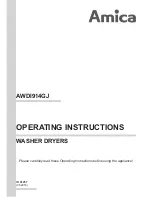
7
10
The hardness of the water varies from place to place. If hard water is used in the dishwasher,
deposits will form on the dishes and utensils.
The appliance is equipped with a special softener that uses a salt specifically designed to
eliminate lime and minerals from the water.
Loading the Salt into the Softener
Always use salt intended for use with dishwashers.
The salt container is located beneath the lower rack and
should be filled as follows:
- Remove the lower rack and then unscrew and remove the
cap from the salt container;
- If you are filling the container for the first time, fill it with
water before adding salt;
- Place the end of the funnel (supplied) into the hole and
introduce about 2 kg of salt. It is normal for a small amount
of water to come out of the salt container.
- Carefully screw the cap back on.
The salt container must be filled when the “low salt” indicator light (located on the control
panel), comes on.
To prevent the formation of rust, carry out a rinse programme without dishes
immediately after loading the salt.
Adjusting Salt Consumption
The dishwasher is designed to allow for adjusting the amount
of salt consumed based on the hardness of the water used.
This is intended to optimize the rate of salt consumption.
To adjust salt consumption, proceed as follows:
- Unscrew the cap from the salt container;
- There is a ring on the container with an arrow on it (see figure
to the side),
- If necessary, rotate the ring in an anticlockwise direction from
the “-” setting towards the “+” sign, based on the hardness for
your area.
It is recommended that adjustments be made in accordance with the following table:
Salt
Water Hardness
Clarke
Selector
degrees
°dH
mmol/l
position
0 - 14
0 - 17
0 - 1.7
*
14 - 36
18 - 44
1.8 - 4.4
-
36 - 71
45 - 89
4.5 - 8.9
mid
71+
89+
8.9+
+
Loading cont..
What not to Load.
Some objects are best washed by hand. These include large silverware items, hand
painted crockery, very soft plastics, antique porcelain and utensils with polished wood
handles.
Since dishwasher detergents tend to be abrasive, 'soft' glassware, cut glass, and lead-
crystal ware should also not be washed in the dishwasher.
Manufacturers often display the 'Dishwasher Safe' stamp on items that are robust
enough to cope with regular dishwashing.
If you ever hear knocking or a breaking noises during a cycle, stop the machine at
once by opening the door very slightly and waiting 15 minutes before opening the
door fully to attend to any problem.
Warning: Do not open the door fully to stop the dishwasher; hot water may be
ejected from the appliance. Allow 15 minutes for the washing activity to
subside and to allow the crockery to cool down to a safe temperature.
IMPORTANT NOTE: In the interest of safety do not place long bladed knives
in the cutlery basket. These items should be laid flat, so as not to cause
accidental injury when unloading your dishwasher.
Cuttlery Basket
The cutlery should be arranged in an orderly manner
inside the basket, with the handles pointing downwards.
Take care during loading to avoid injury from the knife
blades.
The basket is suitable for all types of cutlery, except
those long enough to interfere with the upper spray arm.
Ladles and wooden spoons can be placed in the upper
basket, making sure that the knife blades do not
protrude from the basket.




























